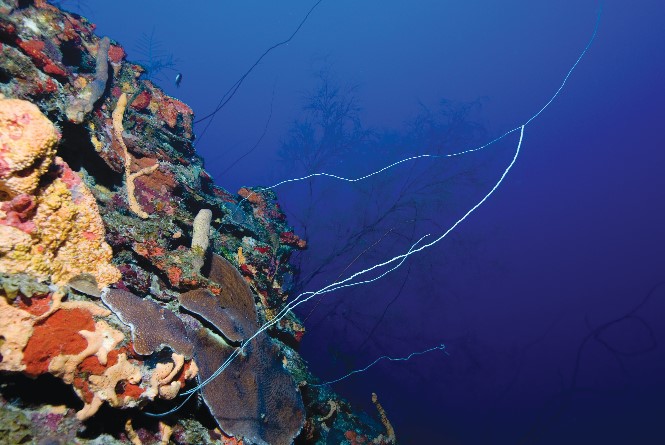Sediment exerts a basic control on the character and distribution of both shallow and mesophotic coral ecosystems (MCEs). In a rare study focused on sediment dynamics of MCEs, NCCOS-supported scientists found that downslope bed-load transport from shallower reefs (by coral and calcareous algae) exceeds suspended-sediment accumulation and has important influence in shaping MCEs in southwest Puerto Rico (found at depths of approximately 40-100 meters). Results also suggest that surface waves may contribute to sediment transport dynamics even at mesophotic depths.

This study focused on two contrasting MCEs off southwest Puerto Rico: a southeast-facing slopewith a gentler gradient and lower relief,and a southwest-facing slopethat is steep and irregular. Downslope sediment transport on low-gradient slopes spread over a broader area (as sheet flow), potentially inhibiting coral recruitment and growth. On steep irregular slopes, downslope transport funnels into narrow channels and chutes, facilitating coral growth on the higher sidewalls and buttresses leading to better developed MCEs.
This project is part of the Deep Coral Reef Ecosystem Studies program in the Caribbean led by the University of Puerto Rico and the Caribbean Coral Reef Institute. Designed to improve the understanding of MCEs off La Parguera, Puerto Rico, the program goals include: characterizing MCE community composition and structure, determining their potential connectivity, and assessing their vulnerability to anthropogenic stresses.
For more information, contact Kimberly.Puglise@noaa.gov.
Citation: Sherman, C., W. Schmidt, R. Appeldoorn, Y. Hutchinson, H. Ruiz, M. Nemeth, I. Bejarano, J.J. Cruz Motta, and H. Xu. 2016. Sediment dynamics and their potential influence on insular-slope mesophotic coral ecosystems. Continental Shelf Research 129: 1-9.
